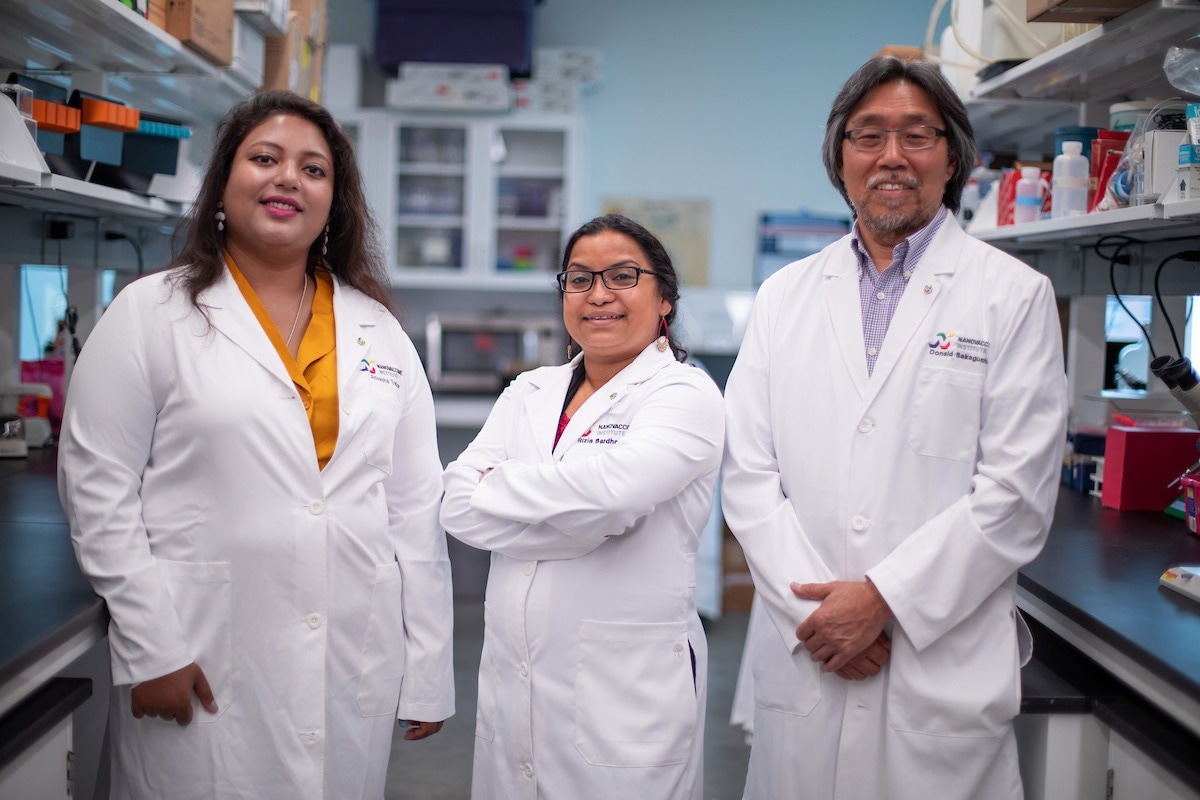Reviewed by Mila PereraSep 21 2022
With one hand, Rizia Bardhan, Associate Professor of chemical and biological engineering at Iowa State University, made a fist, which she then covered with her other hand, similar to a baseball player catching a ball in the net of a fielder’s glove.
 Iowa State University and Nanovaccine Institute researchers, left to right, Anwesha Sarkar, Rizia Bardhan, and Donald Sakaguchi are working to create nanocarriers that deliver drugs across the blood-brain barrier. Image Credit: Christopher Gannon
Iowa State University and Nanovaccine Institute researchers, left to right, Anwesha Sarkar, Rizia Bardhan, and Donald Sakaguchi are working to create nanocarriers that deliver drugs across the blood-brain barrier. Image Credit: Christopher Gannon
The fist signifies a unique nanocarrier filled with medicine; the other hand, a cell deciding whether to catch that nanoparticle and then transport it with the drugs through its protective membrane into its interior.
Bardhan said that sort of cellular uptake relies on two conditions.
First, the surface properties of the nanoparticle have to be satisfactory to the cell. Correct ligands or binders must be present, which will detect the particle as friendly and adhere it to the receiving cell. Second, the particle has to be of the correct stiffness – not too soft or hard – to be received by the cell.
If it’s too soft, it will get stuck in the cell membrane. If it’s too hard, some immune cells will uptake the nanoparticle and clear it out of the cell.
Rizia Bardhan, Associate Professor, Chemical and Biological Engineering, Iowa State University
Therefore, Bardhan and her collaborators have formulated a new method for creating drug-delivering nanocarriers.
Their technology comprises a soft, fat-like, liposome interior (which is a former clinically approved drug carrier) enclosed by a firm shell of gold nanoparticles.
We’re bringing soft and hard together, which is why I call them hybrid nanocarriers.
Rizia Bardhan, Associate Professor, Chemical and Biological Engineering, Iowa State University
Bardhan explained that the particles will not be more than 100 billionths of a meter in width. “This hard and soft provides a broad range of mechanical properties to achieve high cellular uptake,” Bardhan added.
The idea is to utilize the hybrid nanocarriers to carry medicine for epilepsy, Alzheimer’s disease, and other disorders across the blood-brain barrier of the human body, which is a big hurdle arranged by the body to guard the brain against pathogens.
The National Science Foundation is aiding the project with a $650,000 grant spanning three years.
Bardhan’s three co-workers are all from Iowa State University and affiliated with the Nanovaccine Institute situated at Iowa State: Donald Sakaguchi, a Morrill Professor of genetics, development, and cell biology, Saji Uthaman, a research scientist in chemical and biological engineering and Anwesha Sarkar, an assistant professor of electrical and computer engineering.
Sakaguchi will explore the nanocarriers in biological models of the blood-brain barrier, Uthaman and Bardhan will create and improve the nanocarriers, and Sarkar will study the mechanical features of the nanocarriers with the help of an atomic force microscope.
An Unconventional Approach
Bardhan stated that a key goal of the study will be establishing which of the nanocarrier’s molecular and mechanical properties can be worked and altered to efficiently cross the blood-brain barrier.
The scientists will additionally tweak the nanocarriers by employing low-level infrared lasers, like those used by dermatologists, to raise the temperature of the nanocarriers to fever temperatures, which tears their membranes and discharges their medicine cargos to targeted cells.
All of that would advance “drug delivery in difficult to treat disorders of the brain,” the researchers wrote in a project summary. Bardhan stated that those illnesses could include Parkinson’s disease, Alzheimer's disease, epilepsy, ischemic stroke, and seizures.
The scientists wrote that their hybrid, tweaked, and targeted method is generating “unconventional nanocarriers.”
Most researchers usually work at the extremes. They’re working with nanoparticles that are either very hard or very soft. The region between is unexplored.
Rizia Bardhan, Associate Professor, Chemical and Biological Engineering, Iowa State University
This is, still, a favorable place for exploration. As the scientists wrote, “Therapeutic nanocarriers have transformed the landscape of multiple diseases by enabling site-specific drug delivery.”